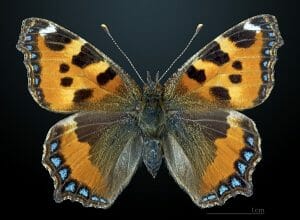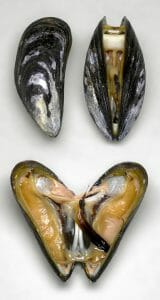Bilateral Symmetry Definition
Bilateral symmetry refers to organisms with body shapes that are mirror images along a midline called the sagittal plane. The internal organs, however, are not necessarily distributed symmetrically.
The vast majority of animals display bilateral symmetry; also known as plane symmetry, this is a trait that applies to 99% of all animals, in the majority of phyla: Chordata, Annelida, Arthropoda, Platyzoa, Nematoda, and most Mollusca.
On the other hand, the Cnidaria display radial symmetry and the Porifera exhibit no symmetry.
The Echinodermata are unique, in that they display bilateral symmetry in their larval stage, and a special form of fivefold radial symmetry, pentamerism in their adult life stage.
Bilaterally symmetrical animals have a dorsal side (top), a ventral side (bottom) and distinct left and right sides. They also have an anterior side (head), and a posterior side (tail), and exhibit cephalization. Cephalization is the clustering of sensory organs at the anterior; a body plan that arose because animals use forward motion, and so this end is the first to encounter the environmental stimuli to which an organism must react. The bilateral body plan may also be advantageous because it permits organisms to be more streamline. This would have been particularly important for ancestral organisms, which moved through the oceans.
To determine whether an animal has bilateral symmetry, it is possible to draw an imaginary (or real!) line down the center from its tip to the end; a bilaterally symmetrical animal will have two sides which are near identical, albeit a mirror image.
Examples of Bilateral Symmetry
Butterflies
Butterflies are an excellent example of near perfect bilateral symmetry. Not only do they have a body shape that can be divided into symmetrical halves, but also the patterns on each wing of a butterfly are near identical to each other.

Humans
The bilateral symmetry in humans has been widely studied, and many advantages of the body type have been determined. It may help us to help the brain recognize when different part of the body are in different positions, making visual perception easier and better coordination of movement. Symmetry is also beneficial in terms of balance, and is important for forward-propelling movement in a specific direction as well as making the process of movement easier; for example, if a human had one leg longer than the other, they would be unable to walk or run effectively in the face of danger, so this is a trait which has stuck as being advantageous through evolution.

Lack of symmetry may be useful for identifying certain health conditions. Additionally, humans have been shown to find faces, which are bilaterally symmetrical, more attractive, as this is an indicator of health and genetic fitness. However, faces are never truly symmetrical, and when examined in fine detail, display much dissimilarity between left and right.
Bivalve Mollusks
Bivalve mollusks are a class of marine or freshwater organisms that have shells consisting of two hinged, bilaterally symmetrical halves; however, some species have secondarily lost their bilateral symmetry, for example oysters and gastropods such as snails. In this group of organisms, the sagittal plane lies along the hinge, which allows the organism to firmly close its shell and protect the soft inner body.

The image shows the shell and internal body of a bivalve mussel. The symmetry of the two halves of the shell can be seen in the bottom image.
Related Biology Terms
- Radial Symmetry – Refers to an organism, which has several planes that it could be cut through, to produce roughly identical pieces.
- Spherical Symmetry – Refers to organisms, which could be cut directly through the center in any direction without distinguishable difference between segments.
- Body Plan – The group of morphological characteristics, which can identify an organism as belonging to a particular taxonomic group, such as a phylum.
Quiz
1. Which area of the body does cephalization occur?
A. The Ventral Side (the bottom)
B. The Dorsal Side (the top)
C. The Anterior Side (the head)
D. The Posterior Side (the tail end)
2. Which of the following is ¬not an advantage of bilateral symmetry?
A. Better control of movement direction
B. Indication of poor health
C. Better Visual perception
D. Allows sensory organs to be distributed throughout the body
3. Which of the following organisms is bilaterally symmetrical?
A. Lobster
B. Starfish
C. Coral Polyp
D. None of the above
